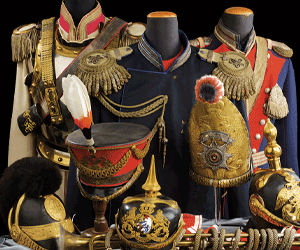Order of St. John, Type II, Knight of Justice Cross
SKU: 01.PRU.0116.104.01
Estimated market value:



Estimated market value:
Attributes
History
The origin of the Royal Order of St. John is in large parts unknown. According to most authors, in 1070, a wealthy merchant from Amalfi built a church (Santa Maria della Latina) near the Holy Sepulcher in Jerusalem, consecrated to St. John the Merciful. Later, John the Baptist was accepted as a patron saint. A knightly order was established over time, following the example of the Templar Order. Hospitals were built and a sovereign state was developed, however the order faced a loss of position to the Turks, and later a loss of property during the French Revolution, along with numerous other challenges.
The Brandenburg ballot of the Johanniter Order was dissolved following the secularisation edict of October 1810. This order was reconstituted by King Friedrich Wilhelm III of Prussia, and it was conferred in two classes, the Grand Master Cross and the Knight Cross, from 1812 to 1852.
The order was conferred at the discretion of the king after he declared Prussia the sovereign protector. The original Grand Master was Prince Augustus Ferdinand of Prussia. After his death in 1813, the Grand Master was Prince Henry of Prussia.
The order was renewed in 1852, and featured the grades of Protector Cross, Knight Master Cross, Commander Cross, Knight of Justice Cross, and Knight of Honour Cross. At this time, becoming a member of the order required payments of a one time 100 thaler entry fee, followed by 12 thalers per year for charitable purposes, specifically nursing and the construction of a hospital. Those who had achieved knighthood by 1810 were carried over without payment. Those who had achieved the knighthood but did not want to be carried over were henceforth known as Knights of Honour. King Friedrich Wilhelm IV reserved the right to appoint a knight of honour in accordance with the provisions established in 1812.
A legal knight had to have been an honourary knight for four years, which he could only become at the age of 30. Knights had to belong to the Protestant denomination and the German nobility (or the nobility of the Prussian monarchy). Any individual who applied to be a knight of honour had to pay 300 Reichstaler for the insignia. The number of knights of honour was unlimited, however they were not introduced into the chapter.
The purpose of the order was to establish hospitals and nursing. In addition, a hospice was maintained for the pilgrims in Jerusalem.
From 1861, foreign rulers, their wives and widows, as well as the master’s wife could be awarded the Cross of the Knights of Honour by the king, to which the crown of the legal knight was added. Ladies wore the decoration on a bow on the left shoulder. Following the death of a recipient, crosses were returned to the general commission.
Beginning in 1864 and continuing in 1866, small decorations of the Order of St. John were added to the Order of the Red Eagle, the Order of the Crown, and the Order of Hohenzollern. This identified the recipient as a knight of the Order of St. John, and was awarded to recognize their services to the wounded during the campaigns.
The Order of St. John saw its destiny in the work of John the Baptist, which was to treat the sick, needy, and the persecuted. The knights had specific goals surrounding hospitality, religious exercises, fight against the infidels, protection of the holy sepulcher and the pilgrims who go there, along with the mission of Christianity.
The cross was representative of these ideas, in that each outflow of the Maltese Cross symbolises the eight blessed of the Sermon on the Mount being:
Terror - the Horrors
Turcuarum - the Unbelievers
Prudencia - Wisdom
Fortaleza - Strength
Justicia - Justice
Temblanza - Fear
Sub Estos Signis Militamus - Let us argue under this sign.
The Protector Decoration (Protektordekoration):
The Brandenburg-Prussian electors and kings regarded themselves as patrons of the order until its dissolution in 1810, however they never belonged to the order, nor wore the insignia. In 1812, the Prussian kings also acted as ‘protectors’ of the order. This post became represented by a physical decoration in 1888, when it was decided that a neck cross with swords and scepters between the top arm and the crown would be worn. The protector was known as the “Most High Knight” and was the sole bearer of the decoration. This decoration was not included in the general commission order and is extremely rare.
The Protector Decoration with Marian Neck Cross was first introduced in 1902, when King Wilhelm II attended a celebration at the Marienburg High Palace and was awarded the Marian Neck Cross. He wore both orders as neck decorations. In 1917, a novelty decoration was captured in paintings illustrating the two orders merged into one. A combined ribbon was created featuring the Marian white and black ribbon and the black ribbon of the St. John Order. The decoration with this ribbon was worn even after the war. Historians speculate this was done because it was more practical and comfortable than wearing numerous decorations.
In 1937, the insignia was changed from a breast cross to a ring. Legal knights wore a ring of silver with the order’s cross in enamel and golden eagles. Knights of Honour wore a ring of silver with the order cross in enamels and silver eagles.
During the war, the Order of St. John was not to be worn with the Wehrmacht uniform.
Type II introduced the divisions into Commander, Knight of Justice (legal knight), and Knight of Honour (honourary knight).
The Knight of Justice was awarded 97 times in 1855. In 1874, 48 legal knights were appointed. In 1893, there were 725 Knights of Justice.
Manufacturers of this decoration include Godet & Sohn (known for a hollow example of 18 karat gold), and S. Friedberg & Sons. There are contemporary crosses in silver gilt.

Versions
$1,400 USD
Gold/Enamelled
45x73mm
$650 USD
Silver gilt/Enamelled
44x70mm
$550 USD
Bronze gilt/Enamelled
44x70mm


Comments
Sign in to comment and reply.


Scroll Top